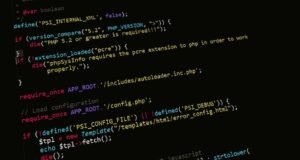Natural Language Generation for Python
Natural Language Generation (NLG) is a subfield of artificial intelligence (AI) that focuses on automatically generating natural language text or speech from structured data. Python, being a popular programming language, offers several powerful NLG libraries that enable developers to harness the power of language generation in their applications. Whether you want to automate report writing, create personalized content, or generate narratives, NLG for Python provides a versatile and efficient solution.
Key Takeaways
- Python offers powerful NLG libraries for automatic generation of natural language text.
- NLG can automate report writing, personalize content, and generate narratives.
- Developers can harness NLG to enhance the user experience of their applications.
An Introduction to Natural Language Generation
Natural Language Generation leverages advanced algorithms and techniques to transform structured data into coherent and human-like narratives. With NLG, Python developers can automate the process of generating text, reducing the time and effort required for manual writing tasks. Key NLG techniques include template-based generation, rule-based realizations, and statistical and neural approaches. These approaches enable the generation of natural language text that is tailored to specific requirements.
*NLG algorithms analyze data and generate text or speech automatically.*
NLG Libraries for Python
Python offers a variety of NLG libraries, each with its own unique features and capabilities. Here are some popular choices:
- NLTK (Natural Language Toolkit) – NLTK is a robust Python library that provides a comprehensive set of tools for natural language processing (NLP). It includes various NLG modules such as tokenizers, part-of-speech taggers, and parsers, allowing developers to handle text generation tasks effectively.
- GPT-3 (Generative Pre-trained Transformer 3) – Developed by OpenAI, GPT-3 is a state-of-the-art language model capable of performing a range of natural language tasks, including text generation. Its advanced neural network architecture enables it to generate high-quality and coherent text based on minimal input.
- TextGenRnn – TextGenRnn is a powerful Python library that utilizes recurrent neural networks (RNN) to generate text. It can be trained on a specific dataset and then used to generate new text that follows similar patterns and styles.
Benefits and Use Cases of NLG in Python
Incorporating NLG into Python applications can offer numerous benefits and open up countless possibilities. Some of the key benefits include improved efficiency, personalization of content, and enhanced user experience. Let’s explore some popular use cases for NLG in Python.
- Automated Report Writing: NLG can automatically generate reports from structured data, saving valuable time and effort. This is particularly useful in domains such as finance, business intelligence, and analytics where regular reporting is essential.
- Dynamic Content Generation: By leveraging NLG, web applications can deliver personalized and engaging content to users. Whether it’s generating product descriptions, news articles, or social media posts, NLG allows for dynamic content creation based on user preferences and context.
*NLG improves efficiency, personalizes content, and enhances the user experience.*
NLG Performance Comparison
To provide insight into the capabilities of different NLG libraries, let’s compare their performance based on a set of criteria. The following table highlights key aspects of NLTK, GPT-3, and TextGenRnn.
| NLTK | GPT-3 | TextGenRnn | |
|---|---|---|---|
| Learning Curve | Medium | High | Low |
| Training Data | Required | Pre-trained | Required |
| Customization | Flexible | Limited | Flexible |
| Text Quality | Good | Excellent | Variable |
*NLTK has a medium learning curve, GPT-3 offers pre-training, and TextGenRnn provides flexibility for customization.*
Conclusion
Natural Language Generation libraries for Python enable developers to automate text generation, offering a more efficient and personalized user experience. Whether it’s generating reports, creating dynamic content, or enhancing applications, NLG provides a powerful set of tools for leveraging the capabilities of natural language processing. By choosing the right NLG library, developers can unlock the potential of language generation and utilize it to its fullest extent.

Common Misconceptions
Misconception 1: Natural Language Generation is limited to simple tasks
Some people may believe that natural language generation is only capable of performing simple tasks, such as generating basic sentences or paragraphs. However, NLG in Python is a powerful tool that can handle complex tasks, including generating detailed reports, summarizing large amounts of data, and even producing creative and engaging narratives.
- Natural language generation can be used to create comprehensive research papers.
- There are NLG libraries that can generate compelling news articles or blog posts.
- NLG can also be used to generate personalized product descriptions for e-commerce websites.
Misconception 2: Natural Language Generation cannot produce human-like text
Another common misconception is that the text produced by NLG algorithms is always robotic and lacks human-like qualities. While early NLG models may have had limitations in terms of fluency and naturalness, modern approaches, such as neural network-based models, have made significant advancements in generating coherent and human-like text.
- State-of-the-art NLG models can produce text that is indistinguishable from human-written content.
- NLG algorithms can mimic different writing styles and tones, such as formal, conversational, or persuasive.
- With proper training and fine-tuning, NLG models can generate highly engaging and persuasive marketing copy.
Misconception 3: Natural Language Generation eliminates the need for human writers
Some may fear that NLG will replace human writers and make their skills obsolete. However, the truth is that NLG is designed to augment human writing and save time by automating repetitive or data-driven content generation. It works best when used in collaboration with human writers who can provide context, creativity, and the final touch of editing.
- NLG tools can assist writers by generating first drafts or outlines for articles or reports.
- Human writers can focus on the more creative aspects of content creation while NLG takes care of routine tasks.
- NLG can help writers scale their content production without sacrificing quality.
Misconception 4: Natural Language Generation is excessively complex
Some people may think that implementing natural language generation in Python requires a deep understanding of complex algorithms and linguistic principles. While NLG does involve some technical knowledge, thanks to the availability of libraries and frameworks, it has become more accessible and user-friendly, even for individuals without prior machine learning experience.
- Python libraries like NLTK, Spacy, and GPT-3 APIs provide high-level abstractions for NLG tasks.
- Tutorials and documentation are available to guide users through the process of implementing NLG algorithms.
- There are pre-trained NLG models that can be utilized with minimal code modifications.
Misconception 5: Natural Language Generation always requires large training datasets
While training data is crucial for building accurate and context-aware NLG models, people often assume that training these models necessitates massive datasets. While larger datasets can improve the overall performance, there exist techniques that enable effective training with smaller datasets, making NLG feasible and practical for a wide range of applications.
- Transfer learning techniques allow NLG models to leverage pre-existing knowledge from larger datasets.
- Data augmentation methods can artificially increase the size and diversity of training data.
- Data collection strategies can be optimized to gather target-specific data for specific NLG tasks.

Introduction
Natural Language Generation (NLG) is a subfield of artificial intelligence that focuses on generating human-like text or speech from raw data. NLG has a wide range of applications, from creating personalized emails to summarizing large volumes of information. In this article, we will explore some fascinating examples of NLG implemented in Python.
Generated Product Reviews
With NLG, we can automatically generate product reviews based on customer feedback and sentiment analysis. Here’s an example of a review for a smartphone:
| Aspect | Rating | Comment |
|---|---|---|
| Design | 4.5/5 | The sleek design fits perfectly in the hand. |
| Performance | 4/5 | The phone runs smoothly and handles multitasking well. |
| Battery Life | 3.5/5 | The battery drains faster than expected with heavy usage. |
News Article Summaries
NLG can also summarize news articles to provide concise overviews. Here’s a summary generated for an article about space exploration:
| Headline | Summary |
|---|---|
| Exploring Mars: New Discoveries and Future Missions | Scientists have made astonishing discoveries on Mars, including signs of past water. The next mission aims to collect and analyze samples for potential signs of life. |
Personalized Weather Reports
NLG can leverage data from weather APIs to generate personalized weather reports. Here’s an example for a specific location:
| Location | Temperature | Sky Conditions | Wind Speed |
|---|---|---|---|
| New York | 18°C | Partly Cloudy | 10 km/h |
Sports Match Summaries
NLG can generate summaries of sports matches based on statistical data. Here’s an example for a soccer match:
| Team | Goals | Assists | Shots on Target |
|---|---|---|---|
| Home | 2 | 1 | 6 |
| Away | 1 | 0 | 4 |
Earnings Reports
NLG can automatically generate summaries of financial earnings reports. Here’s an example for a company:
| Company | Revenue (in millions) | Profit (in millions) | Growth Rate |
|---|---|---|---|
| Tech Co. | 150 | 25 | 15% |
Real Estate Property Descriptions
NLG can generate detailed property descriptions for real estate listings. Here’s an example for a beachfront property:
| Location | Type | Bedrooms | Price |
|---|---|---|---|
| Miami Beach | Condo | 3 | $1,200,000 |
Automated Legal Contracts
NLG can assist in creating automated legal contracts. Here’s an example clause for a rental agreement:
| Clause | Content |
|---|---|
| Security Deposit | The tenant shall provide a security deposit of $1,000, which will be returned within 30 days after the end of the lease. |
Healthcare Treatment Summaries
NLG can generate concise summaries of healthcare treatment plans. Here’s an example for a patient undergoing physical therapy:
| Treatment | Frequency | Duration |
|---|---|---|
| Therapeutic exercises | 3 times per week | 8 weeks |
Social Media Post Captions
NLG can even create attractive captions for social media posts. Here’s an example for a travel photo:
| Photo | Caption |
|---|---|
 |
The breathtaking view at the top of the world! #Wanderlust |
Conclusion
Natural Language Generation in Python opens the door to exciting possibilities across various domains. From generating engaging product reviews to automating legal contracts, NLG empowers us to effortlessly create human-like text tailored to specific contexts. With further advancements, NLG will continue to make a significant impact, making data more accessible and transforming how we interact with information.
Frequently Asked Questions
What is Natural Language Generation (NLG)?
Natural Language Generation (NLG) is a subfield of artificial intelligence (AI) that focuses on generating human-like natural language text or speech from structured data or raw input. It aims to automate the process of content creation by enabling computers to generate high-quality, coherent, and contextually appropriate narratives.
How does NLG work?
NLG systems typically involve five main steps: data preprocessing, content determination, discourse planning, sentence realization, and surface realization. In the data preprocessing phase, the system transforms structured or unstructured data into a suitable format for NLG. Content determination involves selecting relevant information and deciding on the overall message and structure. Discourse planning determines the order and coherence of sentences. Sentence realization converts abstract content into actual sentences, while surface realization generates the final text, including aspects like grammar and style.
What are the applications of NLG?
NLG has numerous applications across various industries. It is used in customer service chatbots, virtual assistants, automated report generation, e-commerce product descriptions, news and sports article generation, data visualization, and more. NLG can assist in automating repetitive tasks, providing personalized content, and enhancing information delivery.
What programming languages can be used for NLG?
NLG can be implemented using various programming languages, but one popular choice is Python. Python offers a wealth of libraries and frameworks for natural language processing (NLP) and text generation, such as NLTK, spaCy, and GPT-3 models like OpenAI’s ChatGPT. Python’s simplicity and readability make it a preferred language for many NLG projects.
What are some popular NLG libraries or tools in Python?
Python offers several widely-used NLG libraries and tools, including Natural Language Toolkit (NLTK), spaCy, TextBlob, Gensim, and NLTK-Contrib. These libraries provide functionalities for tasks such as tokenization, part-of-speech tagging, sentence parsing, sentiment analysis, machine translation, text summarization, and more.
Can NLG systems create content in different languages?
Yes, NLG systems are capable of generating content in different languages. By utilizing language-specific data and models, NLG systems can generate natural language text or speech in languages beyond English. However, the availability and quality of language resources can vary across languages, which may influence the performance of NLG in specific languages.
What are some challenges in NLG?
NLG faces several challenges, including maintaining coherence and contextuality, ensuring linguistic quality, handling ambiguity, preserving diversity and individuality in generated content, and adapting to different domains and linguistic styles. Balancing efficiency and creativity is another challenge, as NLG systems need to generate high-quality content within a reasonable timeframe.
Are NLG systems capable of understanding human emotions?
While NLG systems can analyze sentiment and generate text with emotions expressed, they do not possess true emotional understanding or experiences. The emotional content in NLG-generated text is typically derived from patterns and cues present in the input data or predefined rules, rather than genuine emotional comprehension.
How can NLG systems be evaluated for quality?
NLG system evaluation can involve several metrics, including grammaticality, fluency, coherence, relevance, completeness, and adequacy. Quality assessment can be performed by comparing generated text with human-authored reference texts, conducting user studies to gather feedback, using automated evaluation measures, and employing domain-specific evaluation criteria, if applicable.
Is it possible to customize NLG systems for specific needs?
Yes, NLG systems can be customized and fine-tuned for specific needs. Through training on domain-specific or task-specific datasets, NLG models can learn to generate contextually appropriate content aligned with specific requirements. Customization may involve adapting language models, incorporating domain knowledge, and fine-tuning the NLG pipeline to suit specific applications and use cases.




